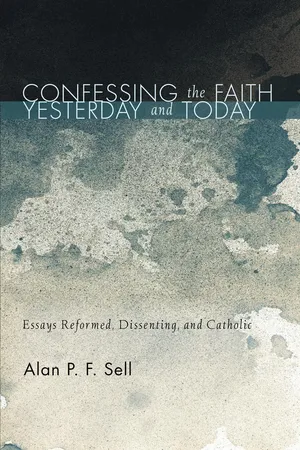
- 318 pages
- English
- ePUB (mobile friendly)
- Available on iOS & Android
About this book
What is it to confess the Christian faith, and what is the status of formal confessions of faith? How far does the context inform the content of the confession? These questions are addressed in Part One, with reference to the Reformed tradition in general, and to its English and Welsh Dissenting strand in particular. In an adverse political context the Dissenters' plea for toleration under the law was eventually granted. The question of tolerance remains alive in our very different context, and in addition we face the challenge of confessing and commending the faith in an intellectual environment in which many question Christianity's relevance and rebut traditional defenses of it. In Part Two it is recognized that Christian confessing is an ecclesial, not simply an individual, calling, and that the one confessing church catholic is visibly divided over doctrine and practice. Suggestions for ameliorating this situation are offered, though the final resolution may be a matter for the eschaton. Until then Christians are called to witness faithfully and to live hopefully as citizens of heaven. In an epilogue the challenges and pitfalls of systematic theology as a discipline involving both confession and commendation are explored.
Frequently asked questions
- Essential is ideal for learners and professionals who enjoy exploring a wide range of subjects. Access the Essential Library with 800,000+ trusted titles and best-sellers across business, personal growth, and the humanities. Includes unlimited reading time and Standard Read Aloud voice.
- Complete: Perfect for advanced learners and researchers needing full, unrestricted access. Unlock 1.4M+ books across hundreds of subjects, including academic and specialized titles. The Complete Plan also includes advanced features like Premium Read Aloud and Research Assistant.
Please note we cannot support devices running on iOS 13 and Android 7 or earlier. Learn more about using the app.
Information
Confessing the Faith in Context
Introduction to Part One
Confessing the Faith and Confessions of Faith
. . . must be capable of statement, else it could not be spread; for it is not an ineffable, incommunicable mysticism.”4 In all of this we see both the importance of doctrinal affirmation, and are cautioned against elevating our confessional statements which, at most, are subordinate standards, above the One to whom they bear witness. If we forget that confessions of faith are subordinate we are on the way to idolatry; if we forget that they are standards, heresy may beckon.
Table of contents
- Title Page
- Preface
- Part One: Confessing the Faith in Context
- Chapter 1: Confessing the Faith and Confessions of Faith
- Chapter 2: Varieties of English Separatist and Dissenting Writings, 1558–1689
- Chapter 3: Separatists and Dissenters amidst the Arguments For and Against Toleration
- Chapter 4: Christianity, Secularism, and Toleration
- Chapter 5: The Use, Abuse,and Relevance of Religion
- Chapter 6: Confessing the Faith in the Intellectual Context
- Part Two: Confessing the Faith Ecclesially and Hopefully
- Chapter 7: Calvin’s Challenges to the Twenty-First-Century Church
- Chapter 8: Rectifying Calvin’s Ecclesiology
- Chapter 9: Receiving from Other Christian Communions and Overcoming the Hindrances Thereto
- Chapter 10: Eschatology
- Chapter 11: Confessing the Faith in Systematic Theology?